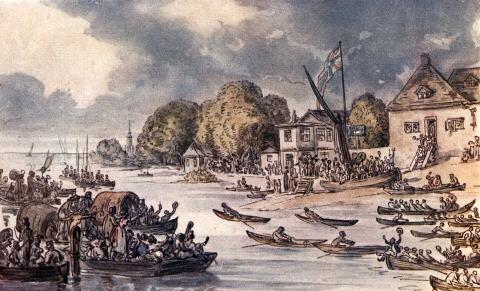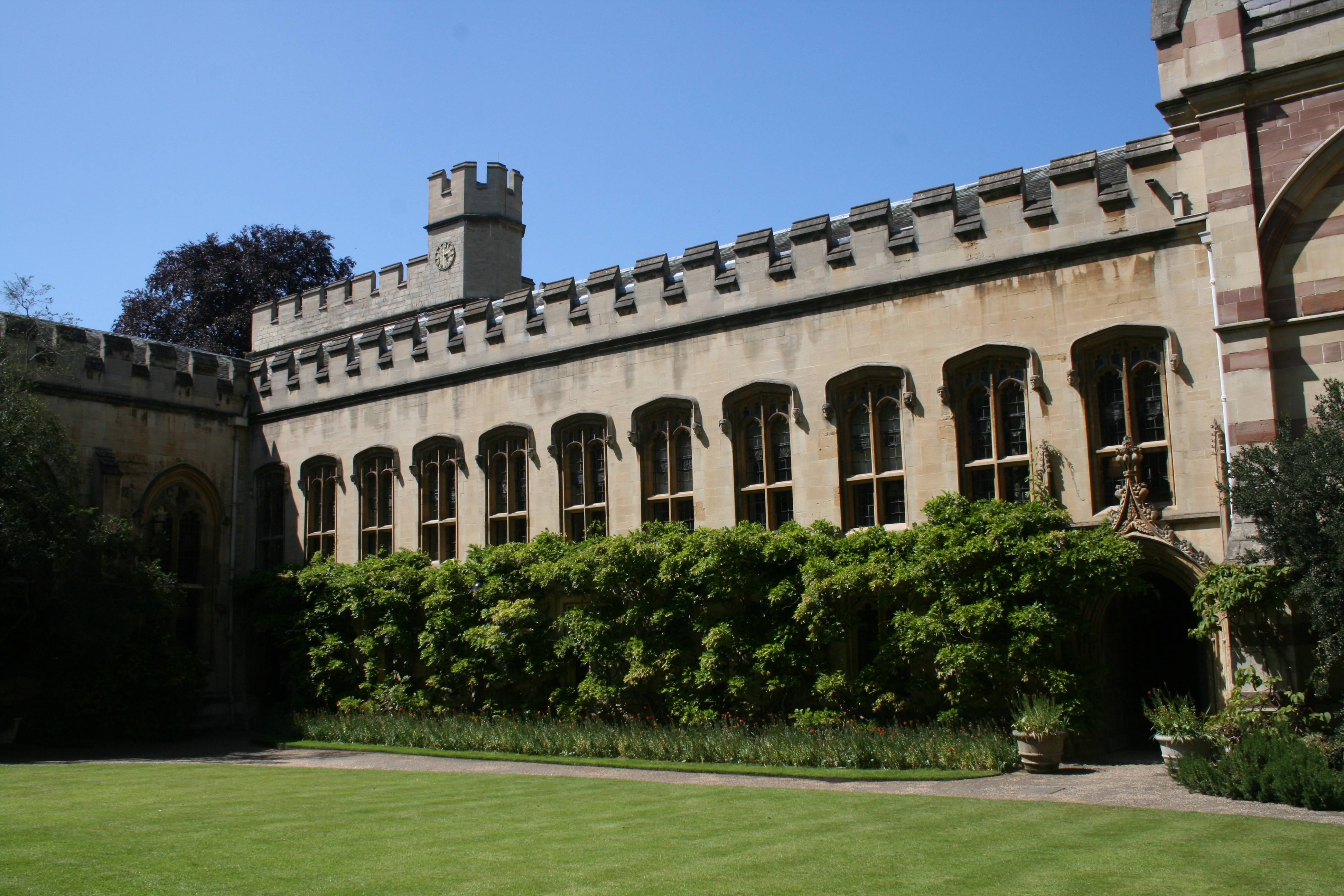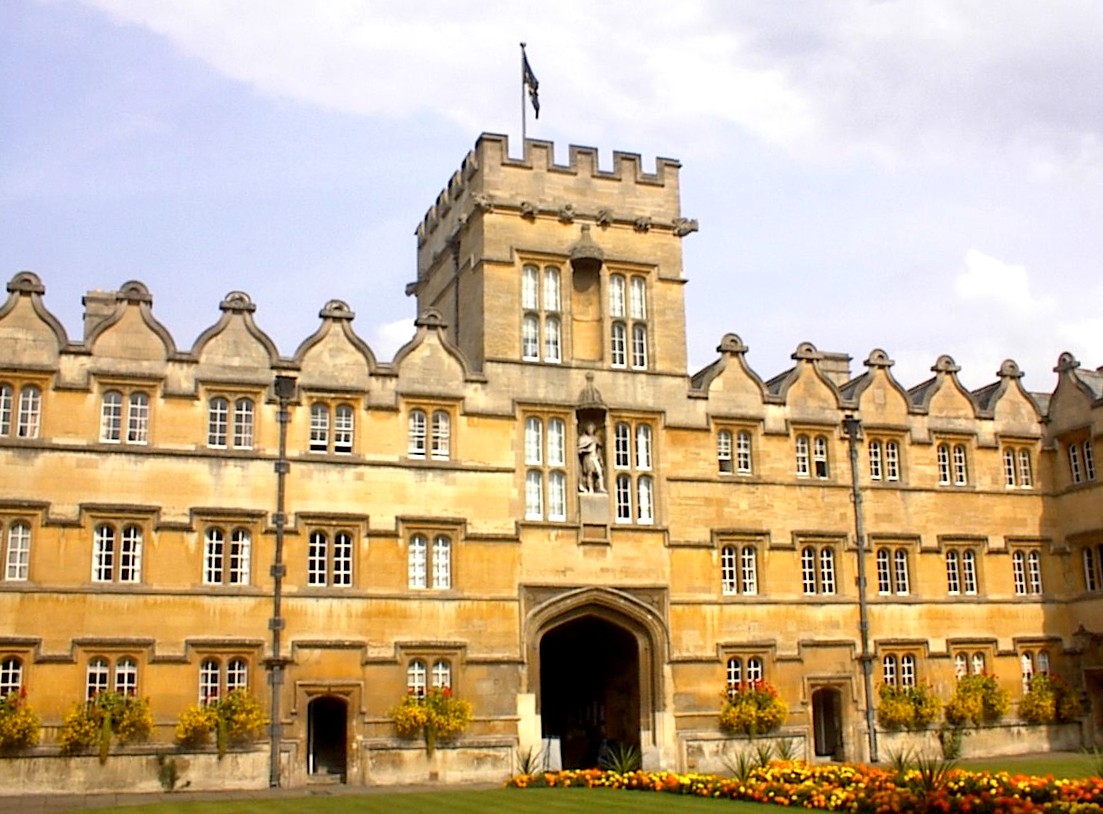|
Eights Week
Eights Week, also known as Summer Eights, is a four-day regatta of bumps races which constitutes the University of Oxford's main intercollegiate rowing event of the year. The regatta takes place in May of each year, from the Wednesday to the Saturday of the fifth week of Trinity Term. Men's and women's coxed eights compete in separate divisions for their colleges. Overview The racing takes place on the Isis, a length of the River Thames, which is generally too narrow for side by side racing. For each division, thirteen boats line up at the downstream end of the stretch, each cox holding onto a rope attached to the bank, leaving around 1.5 boat lengths between each boat. The start of racing is signalled by the firing of a cannon, each crew attempting to progress up their division by bumping the boat in front, while avoiding being bumped by the boat behind. Once a bump has taken place, both of the crews involved stop racing and move to the side to allow the rest of the d ... [...More Info...] [...Related Items...] OR: [Wikipedia] [Google] [Baidu] |
Oriel College Boat Club
Oriel College Boat Club (OCBC) is the rowing club of Oriel College, Oxford. Rowing at Oriel is carried out from the college's own boat-house across Christ Church Meadow, on Boat House Island. Oriel has had three general periods, all with occasional interruptions, in which it has been the foremost college as measured by its most senior men's eight in rowing, as competed at in the two intercollegiate bumps races: Torpids and Eights Week (Summer Eights). These are the early 1840s, the 1933 to 1936 period and 1976 to date. It thus holds the most such wins (headships) of any college. The club's women's eight has also twice won ahead of all other colleges since the admission to women to the college – 1986. Racing In men's rowing at short races, bumps, this is the most successful Oxford college boat club. As of 2020, Oriel holds 37 Torpids Headships, by a large margin, the most of any college and 33 Summer Eights Headships. From 1972 to 1998 Oriel's Men's First Boat was un ... [...More Info...] [...Related Items...] OR: [Wikipedia] [Google] [Baidu] |
Doggett's Coat And Badge
Doggett's Coat and Badge is the prize and name for the oldest rowing race in the world. Up to six apprentice watermen of the River Thames in England compete for this prestigious honour, which has been held every year since 1715. The 4 mile 5 furlongs (7.44 km) race is rowed on the River Thames upstream from London Bridge to Cadogan Pier, Chelsea, passing under a total of eleven bridges. Originally, it was raced every 1 August against the outgoing (falling or ebb) tide, in the boats used by watermen to ferry passengers across the Thames. Today it is raced at a time amenable to spectators, in September, that coincides with the incoming (rising or flood) tide, in contemporary single sculling boats. The winner's prize is a traditional watermen's red coat with a silver badge added, displaying the horse of the House of Hanover and the word "Liberty", in honour of the accession of George I to the throne. In addition, each competitor who completes the course receives a miniature o ... [...More Info...] [...Related Items...] OR: [Wikipedia] [Google] [Baidu] |
Rowing Blade Black
Rowing is the act of propelling a human-powered watercraft using the sweeping motions of oars to displace water and generate reactional propulsion. Rowing is functionally similar to paddling, but rowing requires oars to be mechanically attached to the boat, and the rower drives the oar like a lever, exerting force in the ''same'' direction as the boat's travel; while paddles are completely hand-held and have no attachment to the boat, and are driven like a cantilever, exerting force ''opposite'' to the intended direction of the boat. In some strict terminologies, using oars for propulsion may be termed either "pulling" or "rowing", with different definitions for each. Where these strict terminologies are used, the definitions are reversed depending on the context. On saltwater a "pulling boat" has each person working one oar on one side, alternating port and starboard along the length of the boat; whilst "rowing" means each person operates two oars, one on each side of the b ... [...More Info...] [...Related Items...] OR: [Wikipedia] [Google] [Baidu] |
Christ Church Boat Club Rowing Blade
Jesus, likely from he, יֵשׁוּעַ, translit=Yēšūaʿ, label=Hebrew/Aramaic ( AD 30 or 33), also referred to as Jesus Christ or Jesus of Nazareth (among other names and titles), was a first-century Jewish preacher and religious leader; he is the central figure of Christianity, the world's largest religion. Most Christians believe he is the incarnation of God the Son and the awaited Messiah (the Christ) prophesied in the Hebrew Bible. Virtually all modern scholars of antiquity agree that Jesus existed historically. Research into the historical Jesus has yielded some uncertainty on the historical reliability of the Gospels and on how closely the Jesus portrayed in the New Testament reflects the historical Jesus, as the only detailed records of Jesus' life are contained in the Gospels. Jesus was a Galilean Jew who was circumcised, was baptized by John the Baptist, began his own ministry and was often referred to as "rabbi". Jesus debated with fellow Jews on how ... [...More Info...] [...Related Items...] OR: [Wikipedia] [Google] [Baidu] |
Eights Week
Eights Week, also known as Summer Eights, is a four-day regatta of bumps races which constitutes the University of Oxford's main intercollegiate rowing event of the year. The regatta takes place in May of each year, from the Wednesday to the Saturday of the fifth week of Trinity Term. Men's and women's coxed eights compete in separate divisions for their colleges. Overview The racing takes place on the Isis, a length of the River Thames, which is generally too narrow for side by side racing. For each division, thirteen boats line up at the downstream end of the stretch, each cox holding onto a rope attached to the bank, leaving around 1.5 boat lengths between each boat. The start of racing is signalled by the firing of a cannon, each crew attempting to progress up their division by bumping the boat in front, while avoiding being bumped by the boat behind. Once a bump has taken place, both of the crews involved stop racing and move to the side to allow the rest of the d ... [...More Info...] [...Related Items...] OR: [Wikipedia] [Google] [Baidu] |
Trinity College, Oxford
(That which you wish to be secret, tell to nobody) , named_for = The Holy Trinity , established = , sister_college = Churchill College, Cambridge , president = Dame Hilary Boulding , location = Broad Street, Oxford OX1 3BH , coordinates = , location_map = Oxford (central) , undergraduates = 308 (2011/2012) , graduates = 125 , shield = , blazon = '' Per pale or and azure, on a chevron between three griffins' heads erased four fleurs-de-lis all counter-changed'' (arms of Sir Thomas Pope, Founder) , homepage = , boat_club Boat Club Trinity College (full name: The College of the Holy and Undivided Trinity in the University of Oxford, of the foundation of Sir Thomas Pope (Knight)) is one of the constituent colleges of the University of Oxford in England. The college was founded in 1555 by Sir Thomas Pope, on land previously occupied by Durham College, home to Benedictine monks from Durham Cathedral. Despite its large physical size, the college is relatively sma ... [...More Info...] [...Related Items...] OR: [Wikipedia] [Google] [Baidu] |
Oriel College, Oxford
Oriel College () is a constituent college of the University of Oxford in Oxford, England. Located in Oriel Square, the college has the distinction of being the oldest royal foundation in Oxford (a title formerly claimed by University College, whose claim of being founded by King Alfred is no longer promoted). In recognition of this royal connection, the college has also been historically known as King's College and King's Hall.Watt, D. E. (editor), ''Oriel College, Oxford'' ( Trinity term, 1953) — Oxford University Archaeological Society, uses material collected by C. R. Jones, R. J. Brenato, D. K. Garnier, W. J. Frampton and N. Covington, under advice from W. A. Pantin, particularly in respect of the architecture and treasures (manuscripts, printed books and silver plate) sections. 16 page publication, produced in association with the Ashmolean Museum as part of a college guide series. The reigning monarch of the United Kingdom (since 2022, Charles III) is the official vis ... [...More Info...] [...Related Items...] OR: [Wikipedia] [Google] [Baidu] |
Balliol College, Oxford
Balliol College () is one of the constituent colleges of the University of Oxford in England. One of Oxford's oldest colleges, it was founded around 1263 by John I de Balliol, a landowner from Barnard Castle in County Durham, who provided the foundation and endowment for the college. When de Balliol died in 1268, his widow, Dervorguilla, a woman whose wealth far exceeded that of her husband, continued his work in setting up the college, providing a further endowment and writing the statutes. She is considered a co-founder of the college. The college's alumni include four former Prime Ministers of the United Kingdom ( H. H. Asquith, Harold Macmillan, Edward Heath, and Boris Johnson), Harald V of Norway, Empress Masako of Japan, five Nobel laureates, several Lords of Appeal in Ordinary, and numerous literary and philosophical figures, including Shoghi Effendi, Adam Smith, Gerard Manley Hopkins, and Aldous Huxley. John Wycliffe, who translated the Bible into English, was m ... [...More Info...] [...Related Items...] OR: [Wikipedia] [Google] [Baidu] |
University College, Oxford
University College (in full The College of the Great Hall of the University of Oxford, colloquially referred to as "Univ") is a constituent college of the University of Oxford in England. It has a claim to being the oldest college of the university, having been founded in 1249 by William of Durham. As of 2018, the college had an estimated financial endowment of £132.7m. The college is associated with a number of influential people, including Clement Attlee, Harold Wilson, Bill Clinton, Neil Gorsuch, Stephen Hawking, C. S. Lewis, V. S. Naipaul, Robert Reich, William Beveridge, Bob Hawke, Robert Cecil, and Percy Bysshe Shelley. History A legend arose in the 14th century that the college was founded by King Alfred in 872. This explains why the college arms are those attributed to King Alfred, why the Visitor is always the reigning monarch, and why the college celebrated its millennium in 1872. Most agree that in reality the college was founded in 1249 by William of Du ... [...More Info...] [...Related Items...] OR: [Wikipedia] [Google] [Baidu] |
Worcester College, Oxford
Worcester College is one of the constituent colleges of the University of Oxford in England. The college was founded in 1714 by the benefaction of Sir Thomas Cookes, 2nd Baronet (1648–1701) of Norgrove, Worcestershire, whose coat of arms was adopted by the College. Its predecessor, Gloucester College, had been an institution of learning on the same site since the late 13th century until the Dissolution of the Monasteries in 1539. Founded as a men's college, Worcester has been coeducational since 1979. The Provost is David Isaac, CBE who took office on 1 July 2021 , Worcester College had a financial endowment of £41.9 million. Notable alumni of the college include the media mogul Rupert Murdoch, television producer and screenwriter Russell T Davies, US Supreme Court justice Elena Kagan, Fields Medalist Simon Donaldson, and novelist Richard Adams. Buildings and grounds The buildings are diverse, especially in the main quadrangle: looking down into the main quadra ... [...More Info...] [...Related Items...] OR: [Wikipedia] [Google] [Baidu] |
Exeter College, Oxford
(Let Exeter Flourish) , old_names = ''Stapeldon Hall'' , named_for = Walter de Stapledon, Bishop of Exeter , established = , sister_college = Emmanuel College, Cambridge , rector = Sir Richard Trainor , undergraduates = 346 (2019/2020) , visiting_students = 26 , graduates = 227 , endowment = £74.5 million (2018) , location = Turl Street, Oxford OX1 3DP , coordinates = , location_map = Oxford (central) , homepage = , boat_club = Exeter College Boat Club , JCR JCR, shield = Exeter College Oxford Coat Of Arms (Motto).svg , shield_size = 150px , blazon = ''Argent, two bends nebuly sable'' (arms of Stapledon) ''within a bordure of the last charged with eight pairs of keys, addorsed and interlaced in the rings, the wards upwards, or''. Exeter College (in full: The Rector and Scholars of Exeter College in the University of Oxford) ... [...More Info...] [...Related Items...] OR: [Wikipedia] [Google] [Baidu] |
Christ Church, Oxford
Christ Church ( la, Ædes Christi, the temple or house, ''wikt:aedes, ædēs'', of Christ, and thus sometimes known as "The House") is a Colleges of the University of Oxford, constituent college of the University of Oxford in England. Founded in 1546 by Henry VIII of England, King Henry VIII, the college is uniquely a joint foundation of the university and the cathedral of the Oxford diocese, Christ Church Cathedral, Oxford, Christ Church Cathedral, which both serves as the college chapel and whose Dean of Christ Church, dean is ''ex officio'' the college head. The college is amongst the largest and wealthiest of colleges at the University of Oxford, with an endowment of £596m and student body of 650 in 2020. As of 2022, the college had 661 students. Its grounds contain a number of architecturally significant buildings including Tom Tower (designed by Christopher Wren, Sir Christopher Wren), Tom Quad (the largest quadrangle in Oxford), and the Great Dining Hall, which was the ... [...More Info...] [...Related Items...] OR: [Wikipedia] [Google] [Baidu] |







